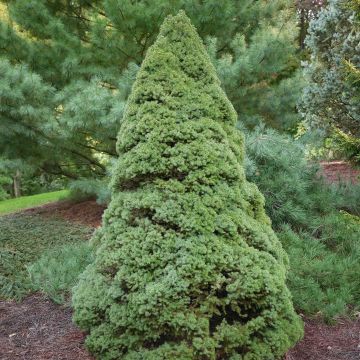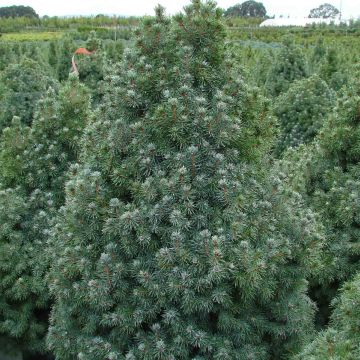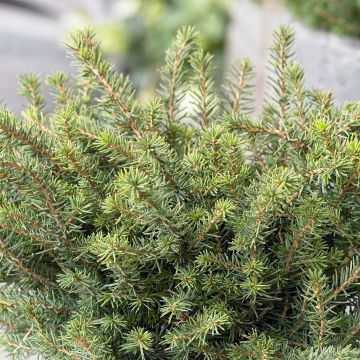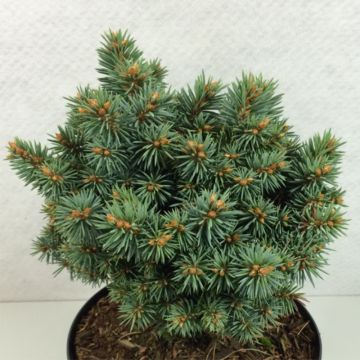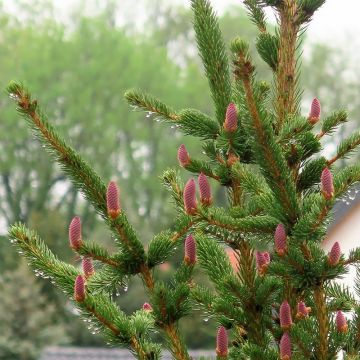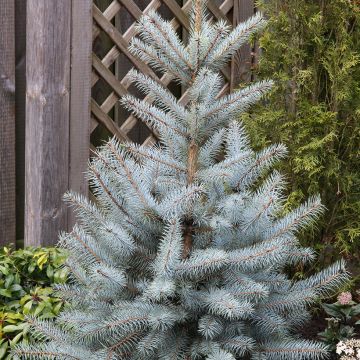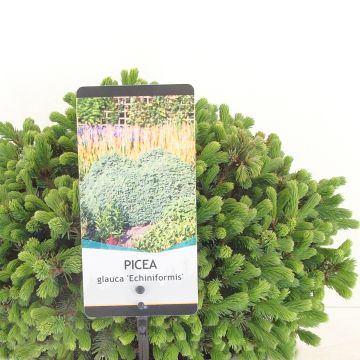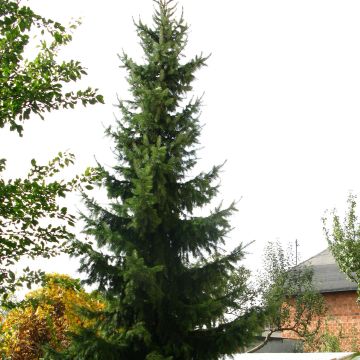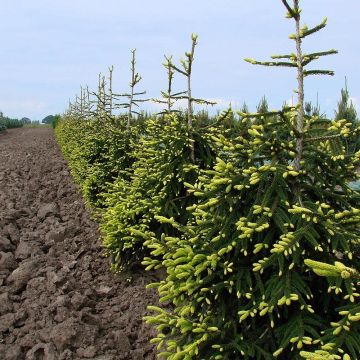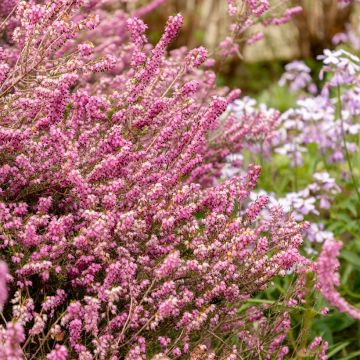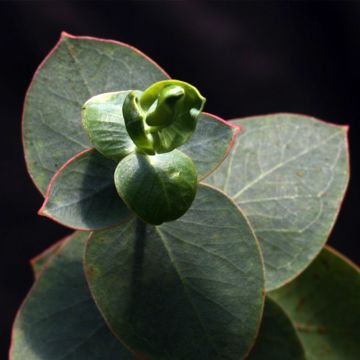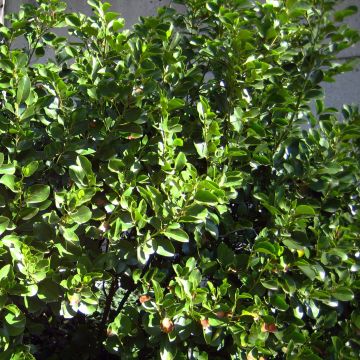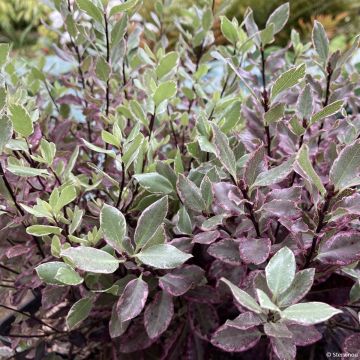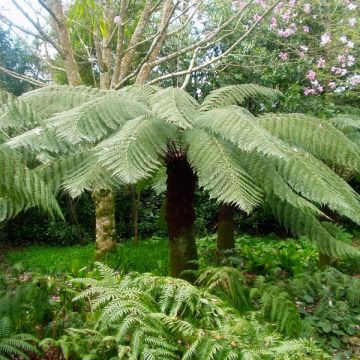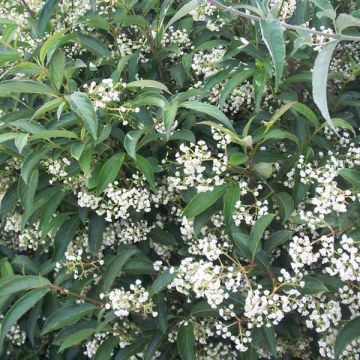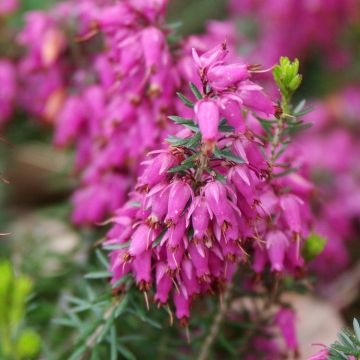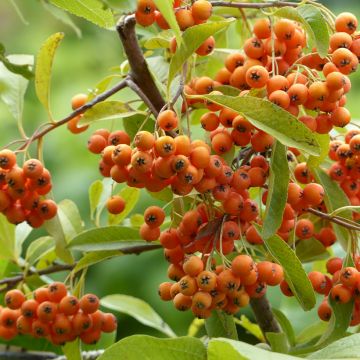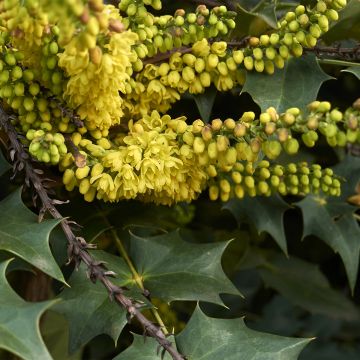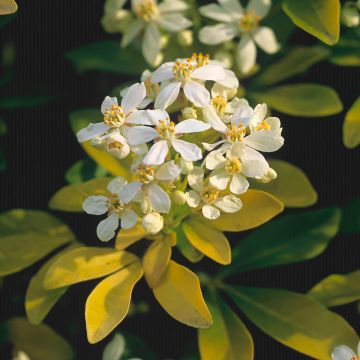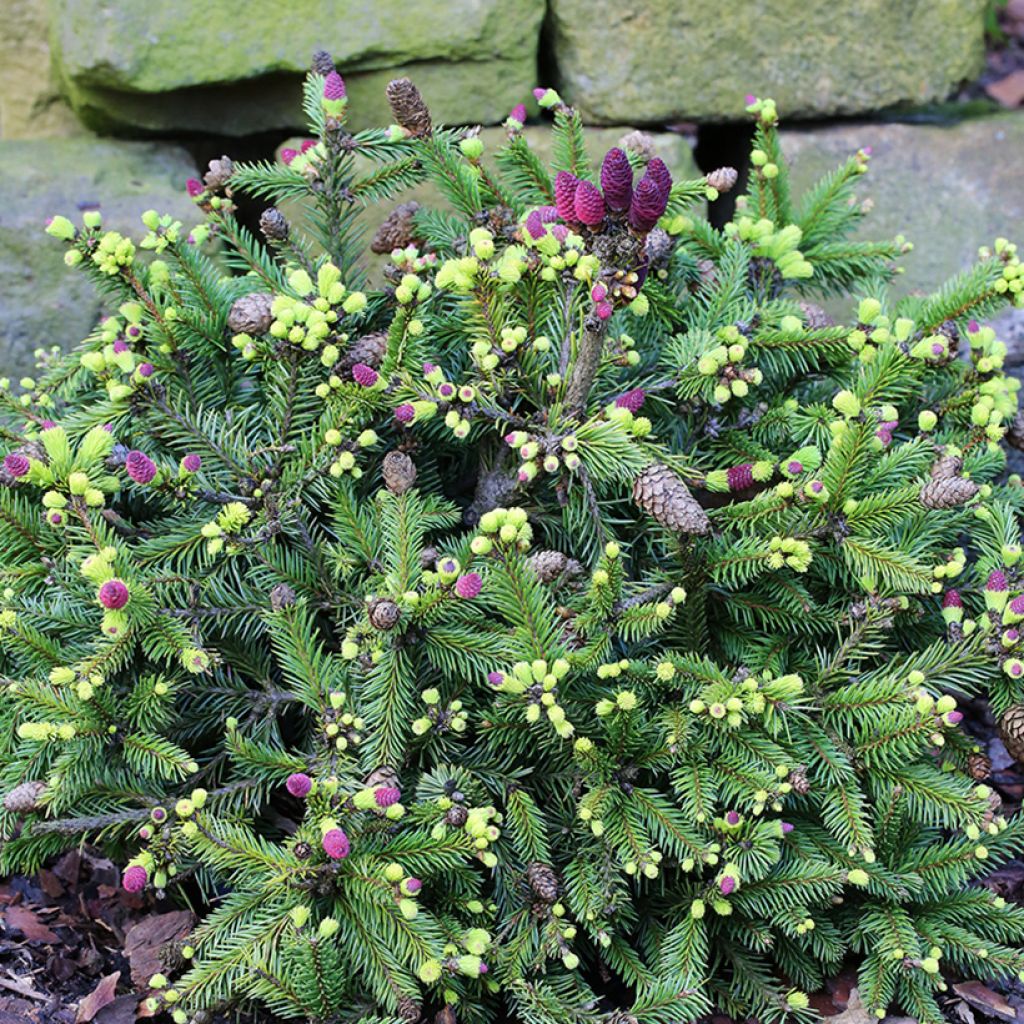

Picea abies Puschv
Picea abies Puschv
Picea abies Pusch
Norway Spruce, Common Spruce, European Spruce
This item cannot be shipped to the selected country
Delivery charge from €5.90
More information
Schedule delivery date,
and select date in basket
This plant carries a 24 months recovery warranty
More information
We guarantee the quality of our plants for a full growing cycle, and will replace at our expense any plant that fails to recover under normal climatic and planting conditions.
From €5.90 for pickup delivery and €6.90 for home delivery
Express home delivery from €8.90.

Does this plant fit my garden?
Set up your Plantfit profile →
Description
Picea abies 'Pusch' is a dwarf variety of common spruce with slow growth, interesting for its slightly irregular wide ball-shaped habit, its bright young shoots, and its truly decorative pink cones in spring. Its somewhat tousled, picturesque silhouette fits into flower beds, enlivens rockeries, or stands out in containers on the terrace. It is very hardy and easy to grow in well-drained, preferably non-chalky soil. This conifer, which dislikes heatwaves, even thrives in light shade.
The Picea abies, also known as Norway Spruce or Red Spruce, is an evergreen conifer belonging to the pinaceae family. It is a species native to northern Europe, specifically Scandinavia. In its natural environment, it has a typically conical and pyramidal habit and can reach a height of 30 m (98 ft 5 in), or even more in Eastern Europe. This species is traditionally used as a Christmas tree in Europe. It prefers well-drained and moist soils and copes with very low temperatures.
The 'Pusch' variety is a dwarf form of Picea abies 'Acrocona'. This variety was named conifer of the year in 2008. Its habit is compact, rounded, and spreading, slightly flared, with branches that go in all directions. Its growth is very slow. After 10 years, it will measure about 60 cm (23.6 in) in height and 1 m (3 ft 4 in) in spread. It produces short branches, densely covered with hard and very short needles, arranged in a brush-like manner. The reddish-brown winter cones are very decorative. Its spring shoots are a bright tender green, turning uniformly green, bright and vivid. In spring, the bush produces ovoid, scale-like, bright pink cones which turn brown in summer and persist until winter. Spruce trees have a shallow and running root system, which makes them difficult to transplant when they are mature and particularly sensitive to wind.
The 'Pusch' Spruce with its beautiful habit, small growth, low maintenance, and ease of cultivation, is a perfect plant for rockeries and terraces. It goes well with large stones, geometric lines, and brickwork. It can be combined with columnar or upright dwarf conifers to play with textures and volumes. The architectural qualities of conifers naturally stand out in a contemporary garden. These plants structurally enhance a flower bed, mark pathways, and border the terrace. They combine well with heathers or ground cover plants such as aubrietas, cerastiums and perennial sages, as well as flowering shrubs. The key is to play with volumes and colours.
Report an error about the product description
Plant habit
Flowering
Foliage
Botanical data
Picea
abies
Pusch
Pinaceae
Norway Spruce, Common Spruce, European Spruce
Cultivar or hybrid
Other Picea
Planting and care
Picea abies 'Pusch' should be planted from September to November and from February to April in deep, well-drained, light, preferably neutral or slightly acidic and moist to dry soil. A sandy, loamy, or rocky soil, with little or no limestone, will be perfectly suitable. Choose a sunny or semi-shaded spot, even shaded in the afternoon, and sheltered from prevailing winds. Soak the root ball well before planting. Add organic fertilizer at planting and water generously for the first few years, especially during prolonged dry periods. Apply a special conifer fertilizer every year in April and weed the soil in the summer. This extremely hardy conifer dislikes heavy soils that become waterlogged in winter. Pruning is not necessary as this plant expresses its full potential when allowed to grow freely.
Planting period
Intended location
Care
-
, onOrder confirmed
Reply from on Promesse de fleurs
Evergreen shrubs
Haven't found what you were looking for?
Hardiness is the lowest winter temperature a plant can endure without suffering serious damage or even dying. However, hardiness is affected by location (a sheltered area, such as a patio), protection (winter cover) and soil type (hardiness is improved by well-drained soil).

Photo Sharing Terms & Conditions
In order to encourage gardeners to interact and share their experiences, Promesse de fleurs offers various media enabling content to be uploaded onto its Site - in particular via the ‘Photo sharing’ module.
The User agrees to refrain from:
- Posting any content that is illegal, prejudicial, insulting, racist, inciteful to hatred, revisionist, contrary to public decency, that infringes on privacy or on the privacy rights of third parties, in particular the publicity rights of persons and goods, intellectual property rights, or the right to privacy.
- Submitting content on behalf of a third party;
- Impersonate the identity of a third party and/or publish any personal information about a third party;
In general, the User undertakes to refrain from any unethical behaviour.
All Content (in particular text, comments, files, images, photos, videos, creative works, etc.), which may be subject to property or intellectual property rights, image or other private rights, shall remain the property of the User, subject to the limited rights granted by the terms of the licence granted by Promesse de fleurs as stated below. Users are at liberty to publish or not to publish such Content on the Site, notably via the ‘Photo Sharing’ facility, and accept that this Content shall be made public and freely accessible, notably on the Internet.
Users further acknowledge, undertake to have ,and guarantee that they hold all necessary rights and permissions to publish such material on the Site, in particular with regard to the legislation in force pertaining to any privacy, property, intellectual property, image, or contractual rights, or rights of any other nature. By publishing such Content on the Site, Users acknowledge accepting full liability as publishers of the Content within the meaning of the law, and grant Promesse de fleurs, free of charge, an inclusive, worldwide licence for the said Content for the entire duration of its publication, including all reproduction, representation, up/downloading, displaying, performing, transmission, and storage rights.
Users also grant permission for their name to be linked to the Content and accept that this link may not always be made available.
By engaging in posting material, Users consent to their Content becoming automatically accessible on the Internet, in particular on other sites and/or blogs and/or web pages of the Promesse de fleurs site, including in particular social pages and the Promesse de fleurs catalogue.
Users may secure the removal of entrusted content free of charge by issuing a simple request via our contact form.
The flowering period indicated on our website applies to countries and regions located in USDA zone 8 (France, the United Kingdom, Ireland, the Netherlands, etc.)
It will vary according to where you live:
- In zones 9 to 10 (Italy, Spain, Greece, etc.), flowering will occur about 2 to 4 weeks earlier.
- In zones 6 to 7 (Germany, Poland, Slovenia, and lower mountainous regions), flowering will be delayed by 2 to 3 weeks.
- In zone 5 (Central Europe, Scandinavia), blooming will be delayed by 3 to 5 weeks.
In temperate climates, pruning of spring-flowering shrubs (forsythia, spireas, etc.) should be done just after flowering.
Pruning of summer-flowering shrubs (Indian Lilac, Perovskia, etc.) can be done in winter or spring.
In cold regions as well as with frost-sensitive plants, avoid pruning too early when severe frosts may still occur.
The planting period indicated on our website applies to countries and regions located in USDA zone 8 (France, United Kingdom, Ireland, Netherlands).
It will vary according to where you live:
- In Mediterranean zones (Marseille, Madrid, Milan, etc.), autumn and winter are the best planting periods.
- In continental zones (Strasbourg, Munich, Vienna, etc.), delay planting by 2 to 3 weeks in spring and bring it forward by 2 to 4 weeks in autumn.
- In mountainous regions (the Alps, Pyrenees, Carpathians, etc.), it is best to plant in late spring (May-June) or late summer (August-September).
The harvesting period indicated on our website applies to countries and regions in USDA zone 8 (France, England, Ireland, the Netherlands).
In colder areas (Scandinavia, Poland, Austria...) fruit and vegetable harvests are likely to be delayed by 3-4 weeks.
In warmer areas (Italy, Spain, Greece, etc.), harvesting will probably take place earlier, depending on weather conditions.
The sowing periods indicated on our website apply to countries and regions within USDA Zone 8 (France, UK, Ireland, Netherlands).
In colder areas (Scandinavia, Poland, Austria...), delay any outdoor sowing by 3-4 weeks, or sow under glass.
In warmer climes (Italy, Spain, Greece, etc.), bring outdoor sowing forward by a few weeks.

































